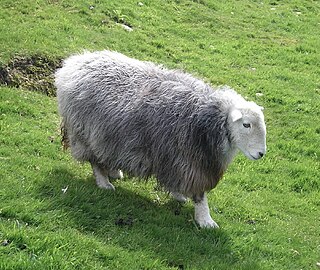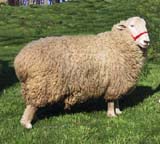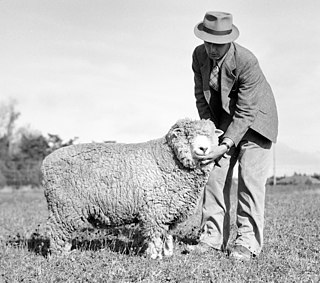
The Merino is a breed or group of breeds of domestic sheep, characterised by very fine soft wool. It was established in Spain near the end of the Middle Ages, and was for several centuries kept as a strict Spanish monopoly; exports of the breed were not allowed, and those who tried risked capital punishment. During the eighteenth century, flocks were sent to the courts of a number of European countries, including France, Hungary, the Netherlands, Prussia, Saxony and Sweden.

The Herdwick is a breed of domestic sheep native to the Lake District in North West England. The name "Herdwick" is derived from the Old Norse herdvyck, meaning sheep pasture. Though low in lambing capacity and perceived wool quality when compared to more common commercial breeds, Herdwicks are prized for their robust health, their ability to live solely on forage, and their tendency to be territorial and not to stray over the difficult upland terrain of the Lake District. It is considered that up to 99% of all Herdwick sheep are commercially farmed in the central and western Lake District.

Sheep farming or sheep husbandry is the raising and breeding of domestic sheep. It is a branch of animal husbandry. Sheep are raised principally for their meat, milk, and fiber (wool). They also yield sheepskin and parchment.

The Coopworth is a modern New Zealand breed of sheep. It was developed by researchers at Lincoln College in the Canterbury region of the South Island between about 1956 and 1968, the result of cross-breeding of New Zealand Romney ewes and Border Leicester rams. It has become the second-most numerous sheep breed in New Zealand, and has been exported to Australia, some European countries, and the United States.
The Perendale is a breed of sheep developed in New Zealand by Massey Agricultural College for use in steep hill situations. The breed is named after Sir Geoffrey Peren, and it achieves its aims by being the offspring of Romney ewes and Cheviot rams with sturdy legs. It is raised primarily for meat.
Polwarth is a breed of sheep that was developed in Victoria (Australia) during 1880. They were of one-quarter Lincoln and three-quarters Merino bloodlines. They are large, predominantly polled sheep with long, soft, quite fine wool and produce good meat carcasses. They were developed in an attempt to extend the grazing territory of sheep because the Merino was found lacking in hardiness in this respect. A dual-purpose breed with a major emphasis on wool production. Richard Dennis, of Tarndwarncoort in south west Victoria, bred the Polwarth, first known as Dennis Comebacks. Descendants of Richards Dennis continue to grow Polwarth wool at Tarndwarncoort, maintaining the original bloodlines in a flock referred to as the "Blue Dots".

The Manx Loaghtan is a rare breed of sheep native to the Isle of Man. It is sometimes spelled as Loaghtyn or Loghtan. The sheep have dark brown wool and usually four or occasionally six horns.

The Border Leicester is a British breed of sheep. It is a polled, long-wool sheep and is considered a dual-purpose breed as it is reared both for meat and for wool. The sheep are large but docile. They have been exported to other sheep-producing regions, including Australia and the United States.

The Romney, formerly called the Romney Marsh sheep but generally referred to by the local farmers as the Kent, is a breed of sheep originating in England. The Romney is a "long-wool" breed recognized in England by 1800. Exported to other continents, the Romney is an economically important sheep breed, especially to the sheep-meat and wool export trades of New Zealand.

The Corriedale is a New Zealand breed of sheep. It was bred from about 1882 in the South Island by James Little, who cross-bred Merino and Lincoln Longwool sheep. The breed was officially recognised in 1911. It has been exported to Australia and to many countries in Africa, Asia, Europe and North and South America. In 2021 it was reported from twenty-five countries, and the total population was estimated at just over 5 million.

The Peppin Merino is a breed of Merino sheep raised for their wool, mostly in Australia. So important is the Peppin Merino that wool producers throughout Australia often classify their sheep simply as being either Peppin, or non-Peppin.

The Dorset Horn is an endangered British breed of domestic sheep. It is documented from the seventeenth century, and is highly prolific, sometimes producing two lambing seasons per year. Among British sheep, it is the only breed capable of breeding throughout the winter.

The raising of domestic sheep has occurred in nearly every inhabited part of the globe, and the variations in cultures and languages which have kept sheep has produced a vast lexicon of unique terminology used to describe sheep husbandry.

Campbell Island sheep are a feral breed of domestic sheep formerly found on New Zealand's subantarctic Campbell Island.

The Galway sheep is a breed of domestic sheep originating in County Galway, in the west of Ireland, based on the earlier Roscommon sheep of neighbouring County Roscommon. They are a large, polled, white-faced sheep, having a characteristic bob of wool on the head and legs. The outer lips are of a dark colour and dark spots on the ears are common. The average litter size is 1.45 in pedigree flocks. While a major proportion of ewes within the bred weigh 80–85 kg and have a litter size of 1.3, there is wide variation to be found. This breed is primarily raised for meat.

Sheep or domestic sheep are a domesticated, ruminant mammal typically kept as livestock. Although the term sheep can apply to other species in the genus Ovis, in everyday usage it almost always refers to domesticated sheep. Like all ruminants, sheep are members of the order Artiodactyla, the even-toed ungulates. Numbering a little over one billion, domestic sheep are also the most numerous species of sheep. An adult female is referred to as a ewe, an intact male as a ram, occasionally a tup, a castrated male as a wether, and a young sheep as a lamb.
The British Milksheep is a robust, dual-purpose sheep commonly known for its milking characteristics.

The history of the domestic sheep goes back to between 11,000 and 9,000 BC, and the domestication of the wild mouflon in ancient Mesopotamia. Sheep are among the first animals to have been domesticated by humans. These sheep were primarily raised for meat, milk, and skins. Woolly sheep began to be developed around 6000 BC. They were then imported to Africa and Europe via trading.
The Sopravissana is a breed of domestic sheep from the province of Macerata, in the Marche in central Italy. The name derives from the area of origin, the comune of Visso in the Monti Sibillini; it was traditionally raised mostly in that area, but flocks ranged into Lazio, Tuscany and Umbria. The Sopravissana derives from the cross-breeding of local ewes with Spanish and Rambouillet Merino rams in the 18th century. It is larger than the Vissana breed from the same area.

The New Zealand Romney is a New Zealand breed of sheep. It derives from British Romney Marsh stock imported to New Zealand in the nineteenth century, and was established as a separate breed in 1904. It is the most numerous sheep breed in New Zealand.





















